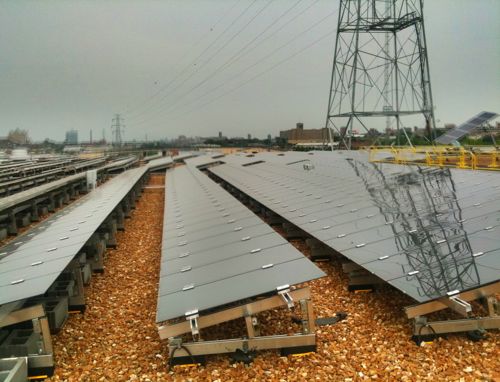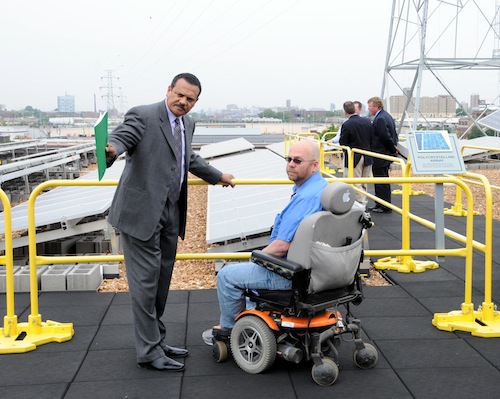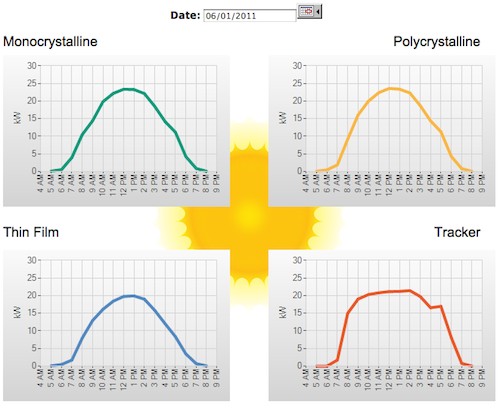Ameren Shows Off Solar Panels & Energy Learning Center

Last week I attended an event at the headquarters of electric utility Ameren. From the press release:
AmerenSolar.com
Ameren Missouri constructed the largest multi-technology solar installation in the state as part of its vision to lead the way to a secure and sustainable energy future. The company is testing four solar technologies to compare performance and reliability in a Midwestern climate.
At AmerenSolar.com, customers can now access, in real-time, data on how much energy each solar technology generates atop Ameren Missouri’s headquarters. Using easy-to-read graphs and charts, the website also provides customers insight into how net metering works, as well as information on rebates and other financial incentives. By advising customers on this issue, they can make a more informed decision whether solar power is right for their home or business.
Energy Learning Center
Hands-on education is available at the Energy Learning Center, located overlooking Ameren Missouri’s rooftop solar installation. Here, tour groups can access the latest information on various renewable energy sources – including solar, energy efficiency options for their homes or businesses, and environmental upgrades throughout the Ameren system. To book a tour for a group or organization, go to the Energy Learning Center Section of AmerenSolar.com.
No matter what questions customers have or which option they choose to find an answer, Ameren Missouri is ready to be their trusted source for energy information.
Interesting, even though a couple of decades late.

I liked that the roof was fully  accessible!

Slight differences between the four types of solar panels. Â Not sure how helpful this data will be to someone considering adding solar panels to their home or business but hopefully it will be.
– Steve Patterson
Would there be a way to make St. Louis a model in retrofitting established urban areas with solar upgrades? What about the idea of forming coops where property owners pool their properties into a group, making space available for the installation of solar panels, and then share in the energy cost savings? LRA properties and undevelopable sites could serve to provide further surface area for more panels in the coop. There might be an advantage to living in an area with more vacant land. Â
Would there be a way to make St. Louis a model in retrofitting established urban areas with solar upgrades? What about the idea of forming coops where property owners pool their properties into a group, making space available for the installation of solar panels, and then share in the energy cost savings? LRA properties and undevelopable sites could serve to provide further surface area for more panels in the coop. There might be an advantage to living in an area with more vacant land.
Rick, the surface area available isn’t the challenge, it’s the high initial cost of the panels and the cyclical nature of their electricity production. Actually, a more viable “alternative” energy solution, here, would be figuring out how harness the rivers’ power for hydroelectric generation. My understanding is that the biggest challenge is that the silt and debris (ice?) in the rivers wreak havoc on the turbine blades. Still, the TVA (Tennessee Valley Authority) might be a model worth emulating.
Steve, the data will be helpful in a cost-benefit analysis and in comparing long-term performance. For example, the tracking panels produce more energy, but cost more and are more complex. The other half of the equation may be falling battery costs. While it would do nothing for Ameren’s business model, if individual homeowners could go “off the grid” for a reasonable cost (5-10 year payback), integrated individual solar systems could become a lot more attractive. Still, installing dispersed solar, with two-way metering, could help Ameren both be more green and meet peak cooling demands on our hot summer days.
Rick, the surface area available isn’t the challenge, it’s the high initial cost of the panels and the cyclical nature of their electricity production. Actually, a more viable “alternative” energy solution, here, would be figuring out how harness the rivers’ power for hydroelectric generation. My understanding is that the biggest challenge is that the silt and debris (ice?) in the rivers wreak havoc on the turbine blades. Still, the TVA (Tennessee Valley Authority) might be a model worth emulating.
Steve, the data will be helpful in a cost-benefit analysis and in comparing long-term performance. For example, the tracking panels produce more energy, but cost more and are more complex. The other half of the equation may be falling battery costs. While it would do nothing for Ameren’s business model, if individual homeowners could go “off the grid” for a reasonable cost (5-10 year payback), integrated individual solar systems could become a lot more attractive. Still, installing dispersed solar, with two-way metering, could help Ameren both be more green and meet peak cooling demands on our hot summer days.
Two comments, first, if you look at the Hope VI project near the Fox, there are large farms of solar panels on the roofs of many of the buildings. Tax credits help to offset the initial cost.
Second, this is probably pretty unreliable, but I saw one calculation for a south facing installation in a STL zio code, paying for itself in 10 years thanks to a 92% reduction in energy cost. After year eleven, presumably, electricity costs are a fraction of normal Ameren charges.
The photo pictured shows Richard Mark not Mark Richardson.
The panels are dead after 8-10 years
Two comments, first, if you look at the Hope VI project near the Fox, there are large farms of solar panels on the roofs of many of the buildings. Tax credits help to offset the initial cost.
Second, this is probably pretty unreliable, but I saw one calculation for a south facing installation in a STL zio code, paying for itself in 10 years thanks to a 92% reduction in energy cost. After year eleven, presumably, electricity costs are a fraction of normal Ameren charges.
The photo pictured shows Richard Mark not Mark Richardson.
The photo pictured shows Richard Mark not Mark Richardson.
Actually, solar power probably won’t be greatest bet for the St. Louis region. Instead, support a new high voltage line from Kansas that is in the permitting stage. The intention is to bring abundent wind energy from the plains east to population centers such as KC and St. Louis. The plus side, its another step in replacing/upgrading the antique transmission grid.Â
Actually, solar power probably won’t be greatest bet for the St. Louis region. Instead, support a new high voltage line from Kansas that is in the permitting stage. The intention is to bring abundent wind energy from the plains east to population centers such as KC and St. Louis. The plus side, its another step in replacing/upgrading the antique transmission grid.
In assuring our demand in
energy we make use of our resources. Solar power has been the next thing that
we can use in the future. It can also produce a high energy voltage that we can
use from day to day.
Solar Power DIY
I see that plants in Nevada are spendingaround $600 Million to build a 110 Mrgawatt facility. That is nearly $6.00 a watt! Now that is a huge facility and will never ahve a payoff. I am cuurently paying $0.13 per KILOWATT or $0.00013 per watt. The cost of nuclear in about $.02 per kilowatt. Let me see $6000 a Kilowatt or 2 cents. Not much of a choice in my mind.
I cannot find any data on the system reliability. Yes solar panels just work but what about the DC Inverters? The power regulators. I have repaired electronics for a great portion of my life and I doubt that these items that handle large amounts of power don’t fail. I personally think the data is being hidden so that the real costs in solar don’t appear as bad as they really are.
I see that plants in Nevada are spendingaround $600 Million to build a 110 Mrgawatt facility. That is nearly $6.00 a watt! Now that is a huge facility and will never ahve a payoff. I am cuurently paying $0.13 per KILOWATT or $0.00013 per watt. The cost of nuclear in about $.02 per kilowatt. Let me see $6000 a Kilowatt or 2 cents. Not much of a choice in my mind.
I cannot find any data on the system reliability. Yes solar panels just work but what about the DC Inverters? The power regulators. I have repaired electronics for a great portion of my life and I doubt that these items that handle large amounts of power don’t fail. I personally think the data is being hidden so that the real costs in solar don’t appear as bad as they really are.
The panels are dead after 8-10 years
Proper compass direction of installation might have more to do with energy production for home-use than technology, but these graphs tell me that I would definitely be buying the “Tracker” technology (at least from this one day’s worth of data). Â Max production is not the lowest, and it stays at its max for a longer part of the day. Â And getting more of this data just became a project for my math classes next year… 🙂
Proper compass direction of installation might have more to do with energy production for home-use than technology, but these graphs tell me that I would definitely be buying the “Tracker” technology (at least from this one day’s worth of data). Max production is not the lowest, and it stays at its max for a longer part of the day. And getting more of this data just became a project for my math classes next year… 🙂
Accounting
Certificate
Good post here Steve. The world’s concern about the future brings about the development and improvement of alternative sources of energy systems. Harnessing the power of the sun and wind costs a lot of money but if properly implemented, one can sane money and energy and at the same time help the environment.
This is very interesting! Looking for renewable energy is very important because these days we have energy shortage.This article is a way to remind us that nature brings a lot to us like sources of energy.
cashflow club nederland
Awesome post Patterson! The way you explained the difference
between the solar panels with graph really good to understand and help people
to choose the right solar panels system for their house. Keep posting!
I’m sure that people could really save a lot if they will going to use solar panels as source of the electricity.
RMT Toronto